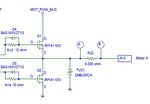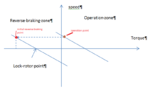gsecer
Junior Member level 1

Hi;
I'm trying to control a BLDC motor using the attached circuit. However, MOSFETS burn when I apply full reverse voltage to brake the motor.
The bus voltage is 48V. The inductance of the motor is 0.06mH.
Can you help me figure out what's the problem? Does it have anything to do with TVS?
Thanks in advance
Gorkem
I'm trying to control a BLDC motor using the attached circuit. However, MOSFETS burn when I apply full reverse voltage to brake the motor.
The bus voltage is 48V. The inductance of the motor is 0.06mH.
Can you help me figure out what's the problem? Does it have anything to do with TVS?
Thanks in advance
Gorkem





